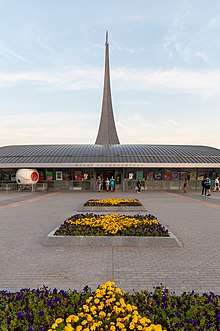Memorial Museum of Cosmonautics
The Memorial Museum of Cosmonautics (Russian Музей космонавтики, also known as the Memorial Museum of Astronautics (in English) or Memorial Museum of Space Exploration) is a museum in Moscow, Russia, dedicated to space exploration. It is located within the base of the Monument to the Conquerors of Space in the north-east of the city.[1] The museum contains a wide variety of Soviet and Russian space-related exhibits and models which explore the history of flight; astronomy; space exploration; space technology; and space in the arts. According to the Russian tourist board, the museum's collection holds approximately 85,000 different items and receives approximately 300,000 visitors yearly.[2]
| Музей космонавтики | |
 The entrance to the Museum (2019) | |
| Agency overview | |
|---|---|
| Formed | 1981 |
| Jurisdiction | Government of Russia |
| Agency executive |
|
| Website | |
History
Though the space monument's tower was erected in 1964, the memorial museum did not exist for another seventeen years. Opening ceremonies took place on April 10, 1981, to commemorate the 20th anniversary of the day Yuri Gagarin became the first human to orbit the Earth in space.[2]
The museum primarily focuses on the Soviet space program with major themes like Gagarin, Sergey Korolev, Sputnik and Soyuz.
Renovation
On Cosmonautics Day, 2009, the museum was reopened after three years of reconstruction. It has virtually tripled its original size and has added new sections dedicated to space programs worldwide, including the USA, Europe, China and the International Space Station. The museum now features original interactive exhibits, as well as a refurbished promenade, the sculpture-lined Cosmonauts Alley which connects the museum to the Moscow metro. The museum is a favourite of students worldwide and a primary tourist attraction of the city.[3]
Exhibits
- Soviet Krechet spacesuit.
- Rocket propulsion units, RD-214.
 Space capsule used by Yuri Gagarin.
Space capsule used by Yuri Gagarin.- Soviet moonrover Lunokhod (Луноход).
 Crew manual from Apollo-Soyuz Test Project (1974), in Russian and English.
Crew manual from Apollo-Soyuz Test Project (1974), in Russian and English. Poster art of the Soviet space program.
Poster art of the Soviet space program. USSR flag display with Moon fragments. Presented as a gift to Soviet citizens by President Richard Nixon in June 1970
USSR flag display with Moon fragments. Presented as a gift to Soviet citizens by President Richard Nixon in June 1970 The engraved fence surrounding the complex. Engraved with a picture of Sputnik 1
The engraved fence surrounding the complex. Engraved with a picture of Sputnik 1
References
- Moon Moscow and St. Petersburg; J. Chater and N. Toohey, ed.; Public Affairs, 2009; p.171.
- "Russian Museums Guide".
- Moon, p.171.
External links
- Museum of Cosmonautics official website (in Russian)
- The Museum of cosmonautics from The official Russian museums list.
- Museum of Cosmonautics at Google Cultural Institute
| Wikimedia Commons has media related to Memorial Museum of Cosmonautics. |
